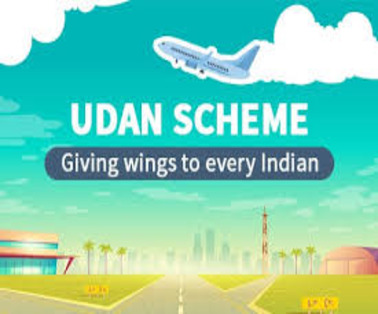UDAN Scheme also known as Ude Desh Ka Aam Nagrik scheme is the regional connectivity scheme RCS. It was launched with the aim of taking flying to the masses by improving air connectivity for tier-2 and tier-3 cities.
Key Highlights of the UDAN Scheme
- The government’s biggest claim to success in aviation since 2014 is building “74 airports in seven years”, as opposed to the same number built in the seven decades since Independence.
- However, only 11 of these airports have actually been built from scratch, while 15 airports have fallen into disuse over this period, due to the collapse of almost half the routes launched under the regional connectivity scheme (RCS).
- In the recent past, airport development has primarily been undertaken under the RCS, which was launched in 2017 to improve air connectivity for smaller cities, and to redevelop under-utilised airports.
- This largely involved the revival of old airstrips that were either lying unused or were used sparsely.
- The government launched 479 routes to revive these airports, out of which 225 have since ceased operations
Challenges of UDAN Scheme
Airport Development
- Only 11 greenfield airports have become operational since May 2014.
- The figure of 74 new airports, includes nine heliports and two waterdromes. These two waterdromes, built for seaplanes between Gujarat’s Gandhinagar and the Statue of Unity in Kevadia, closed down soon after the PM’s launch in October 2020
- As many as 15 airports, including Sikkim’s only airport in Pakyong, and those in Punjab’s Adampur, Pathankot, and Ludhiana do not see any flights anymore
Commercially unviable
- Of the 225 routes that have ceased operations, 128 routes shut down even before completing the mandatory three-year period under the scheme.
- Airlines found 70 of these routes to be commercially unviable despite the subsidy, while the remaining 58 have been cancelled either due to “non-compliance” by the airline operator, or the airline surrendering routes, or the airline companies shutting down, as in the case of Air Deccan and Air Odisha.
- As many as 97 routes shut down after completing the three-year period during which the government provides support.
- The objective of the scheme was that after the three-year period, airlines would be able to sustain operations on their own without government support, but out of the 155 routes that have completed three years, only 58 have survived.
Low demand
- The scheme aims to connect underserved and unserved airports in Tier-II and Tier-III cities, but the demand for air travel in these regions is still very low. Many of the routes have very low load factors, making them unviable for the airlines.
Inadequate infrastructure
- Many of the airports under the scheme are not equipped with the proper facilities and infrastructure to handle regular flights. Some of them lack basic amenities such as parking bays, terminal buildings, security systems, fire-fighting equipment, and air traffic control. Some of them also have operational constraints such as short runways, poor visibility, and adverse weather conditions.
Regulatory hurdles
- The scheme requires the airlines to comply with various regulatory norms and conditions, such as minimum frequency, route exclusivity, fare capping, and seat allocation. These rules restrict the flexibility and efficiency of the airlines and create barriers to entry and exit.
Operational challenges
- The airlines face several operational challenges in running these flights, such as crew shortage, aircraft availability, maintenance issues, slot allocation, and network integration. The airlines have to deploy smaller aircraft for these routes, which have limited availability and higher maintenance costs.
Features Of UDAN Scheme
- It is the flagship Regional Connectivity Scheme of the Ministry of Civil Aviation (MoCA).
- It aims to fulfil the aspirations of the common man with an enhanced aviation infrastructure and air connectivity in tier II and III cities.
- It was formulated based on the review of The National Civil Aviation Policy (NCAP)-2016 and it was planned to remain in force for a period of 10 years.
- RCS-UDAN was awarded the Prime Minister’s Award for Excellence in Public Administration under Innovation Category for the year 2020.
Objectives Of UDAN Scheme
- To develop the regional aviation market.
- To provide affordable, economically viable and profitable air travel on regional routes to the common man even in small towns.
Subsidising Routes in UDAN Scheme
- The routes are awarded after a bidding process, and the winning airlines are given certain incentives, along with viability gap funding (or a subsidy) equivalent to 50% of the seating capacity on their aircraft.
- In return, the airlines sell 50% of their seats at a flat rate of ₹2,500 per hour of flight, in order to make air travel affordable.
- The cost of the subsidy is borne by Indian airlines flying on non-RCS routes, who pay an RCS levy of ₹15,000 per departure, as per the latest revision that came into effect in April 2023.
- The airlines further pass the levy on to their passengers on non-RCS flights. A total sum of ₹2,038 crore has been collected as RCS levy.
- The scheme also set aside a sum of ₹4,500 crore to revive old airports by recarpeting runways and erecting terminal buildings.
- Of these, 46 airports have been redeveloped by the Airports Authority of India, and the remaining by State governments and Public Sector Units
Types Of UDAN Scheme

Benefits of UDAN Scheme
- The launch of the regular flight operations on the route will further provide a catalyst to trade & tourism of the region.
- This scheme will improve the standard of living in the country.
- Through this scheme, air travel will be made affordable and widespread.
- Unserved regions have received the direct and indirect benefits of air connectivity for their economic development
To Download Monthly Current Affairs PDF Click here
Get Inspiration from CLAT 2025 Topper
Click here to get a free demo
Everything About CLAT 2025



